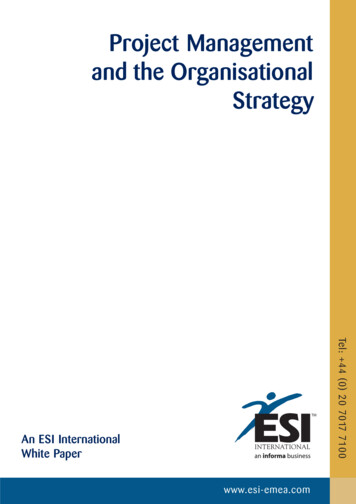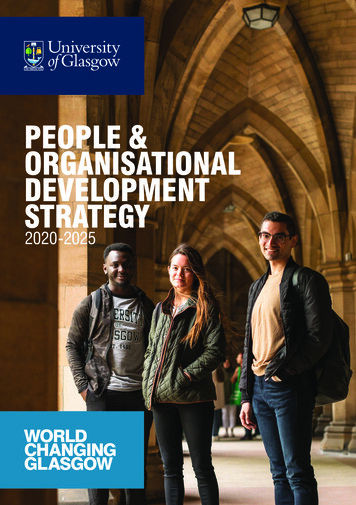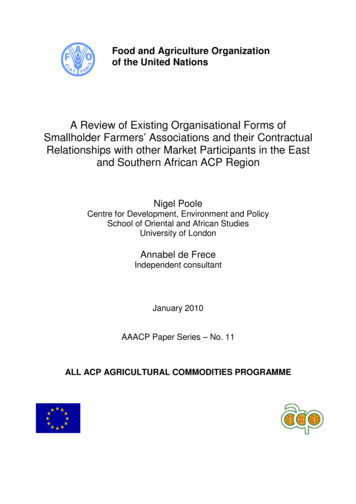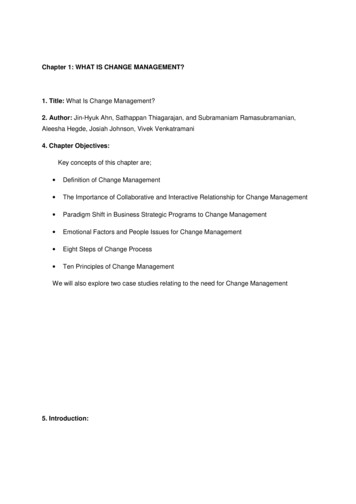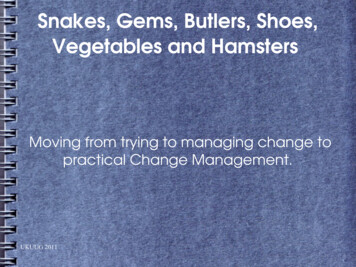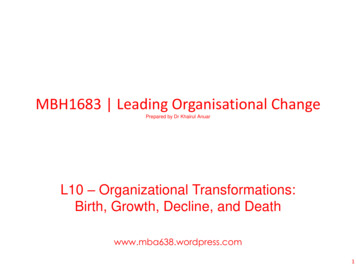
Transcription
MBH1683 Leading Organisational ChangePrepared by Dr Khairul AnuarL10 – Organizational Transformations:Birth, Growth, Decline, and Deathwww.mba638.wordpress.com1
Learning Objectives Appreciate the problems involved in surviving the perilsof organizational birth and what actions founders cantake to help their new organizations survive Describe the typical problems that arise as anorganization grows and matures, and how anorganization must change if it is to survive and prosper Discuss why organizational decline occurs, identify thestages of decline, and describe how managers can workto prevent the failure and even the death or dissolution ofan organization2
The Organizational Life Cycle Why do some organisations survive and prosper whileothers fail or die? Researchers suggest that we need to understand thedynamics that affect organizations as they seek asatisfactory for with their environment Organizational life cycle: A sequence of stages of growthand development through which organizations may pass The four principal stages of the organizational life cycle:– Birth– Growth– Decline– Death3
Figure 11.1 - A Model of the Organizational LifeCycle4
The Organizational Life Cycle Organisations pass through these stages at different rates, andsome do not experience every stage Some companies go directly from birth to death without enjoyingany growth if they do not attract any consumers or resources Some organisations spend a long time in the growth stage , andresearchers have identified various sub-stages of growth whichan organisations must navigate There are also sub-stages of decline Some organisations in decline take corrective action, changequickly, and turn themselves around The way an organization can change in response to the problems itconfronts determines whether and when it will go on to the nextstage in the life-cycle and survive and prosper or fail or die.5
Organizational Birth Organizational birth: The founding of an organization Occurs when entrepreneurs take advantage ofopportunities to use their skills and competences tocreate value Dell - found new way to market low-priced computers They saw an opportunity to found an organisationthat could produce lower price products than thecompetition6
Organizational Birth (cont.) A dangerous life cycle stage associated with the greatestchance of failure– Liability of newness: The dangers associated with being the first in anew environment– It lacks a formal structure to give its value creation processes andactions reliability and stability. At first, all it activities are performed by trial and error,organizational structure emerges gradually as decisions aremade about roles, rules, and SOPs should be implemented. In this stage, the structure is flexible and responsive, allowingthe org to adapt and perfect its routines to meet the needs ofits environment– Conditions in the environment may be hostile to a new organization– eg resources for example may be scarce or difficult becausemany established organizations are competing for them Entrepreneurs bear this uncertainty because they stand to earnpotentially enormous returns if their business takes off7
A Population Ecology Model of OrganizationalBirth Population ecology theory: A theory that seeks to explain the factorsthat affect the rate at which new organizations are born (and die) in apopulation of existing organizations– Population of organizations: The organizations that are competingfor the same set of resources in the environment Eg. restaurants in university town (like Cyberjaya) competing toattract environmental resources in the from of from thestudent population Dell, HP, Acer etc to attract environmental resources in the formof from consumers willing spend in personal computing– Different organisations within a population may choose to focus ondifferent environmental niches, or particular sets of resources orskills.– Eg. Initially Dell chose to focus on the mail-order niche of the PCenvironment, HP focused on business niche, and apple onpublishing and higher education niche. Their choices have changedover time to gain access to more resources. Apple started its chainof stores to attract individual customers, and in 2007 Dell decided toexpand its sales channels to reach more customers by selling inPCs stores8
Population Ecology Model (cont.) Number of births determined by the availability ofresources– Population density: The number of organizations thatcan compete for the same resources in a particularenvironment– Factors that produce a rapid birthrate Availability of knowledge and skills to generatesimilar new organizations New organizations that survive provide role modelsand confer legitimacy Eg Amazon/Groupon/Uber spin-offs9
Population Ecology Model (cont.) As the environment is populated with a numberof successful organizations, birthrate tapers offbecause:– Fewer resources are available for newcomers First-mover advantages: Benefits derived from being anearly entrant into a new environment Eg Uber/Amazon/Microsoft Includes customer support, recognized brand name,and the best locations for new business like restaurants Latecomers enter environ that is partially depleted ofthe resources that they need to grow – eg banksreluctant to lend money to new comers becausechance of survival in competitive environment may bepoor10
Population Ecology Model (cont.) Have to compete for resources – which may be moredifficult and expensive to obtain. For new customers,new company may need to overspend on advertising orinnovation, or they may need to reduce their prices toomuch. Existing companies may band together and makeit very hard for new companies to enter the market –collusion, agreeing to set prices at artificially low levels todrive out new rivals out of the industry, or erect barriersto entry11
Figure 11.2 - Organizational Birthrates OverTime12
Population Ecology Model (cont.) Survival strategies– Strategies that organizations can use to gain accessto resources and enhance their chances of survival inthe environment– r-strategy versus K-strategy r-strategy: A strategy of entering a new environment,they are early entrants K-strategy: A strategy of entering an environment late,after other organizations have tested the environment13
Population Ecology Model (cont.) r-strategy – advantages – first mover advantage and first pickof the resources in the environment. If able to grow rapidly,and develop skills and procedures it will increase its chanceof surviving and prospering K-strategy – organisation which are established in otherenvironments and wait to enter a new environments until theuncertainty in that environments is reduced and the correct way tocompete is apparent. Eg Samsung and Sony only entered the cellphone market afterMotorola and Nokia had showed how big the global market sizewas. They then use the skills developed in other environment anduse them to develop effective procedures that allow them tocompete with and often dominate organisations following r-strategy. In the PC market, IBM which was dominate seller of main framecomputes entered into the PC mkt14
Population Ecology Model (cont.) Specialist strategy versus generalist strategy– Specialists: Organizations that concentrate their skillsto pursue a narrow range of resources in a singleniche. Eg smartphones– By focusing their activities in one niche specialistsare often to dev core competencies that allow them tooutperform generalists in that niche.– Eg offer better customer service. Nvidia – leader ingraphics chips invest all its resources to producethese state-of-the-art chips and does not investresources to compete with Intel or AMD in makingmicroprocessors or memory chips15
Population Ecology Model (cont.) Specialist strategy versus generalist strategy– Generalists: Organizations that spread their skills thinto compete for a broad range of resources in manyniches . Eg smartphones, inexpensive cell phones,landline phones, pagers, etc– Generalist can often outcompete specialists whenthere is considerable uncertainties in the environmentand they when resources are changing so that nichesemerge and disappear continually.– Generalist can survive in an uncertain environmentbecause they have spread their resources over manyniches.– If specialist’s niche disappears, however, there is amuch higher chance of org failure and death.16
Population Ecology Model (cont.)– Specialist & generalist strategy – normally co-existin many environments because generate create theconditions that allow specialist to operatesuccessfully.– Eg. large department store stock many differenttypes of clothing but can stock a limited amount ofeach type, eg sportswear. Specialist stores canstock may offer extensive type of clothing egsportswear, and therefore charge a premium pricefor their selection of unique cloths. Even though there were powerful generalistaround – as Apple has showed with its iPodsand iPhones17
Population Ecology Model (cont.) Process of natural selection– Two sets of strategies result in: r-Specialist, rGeneralist, K-Specialist, K-Generalist Early in an environment, new organizations are likely tobecome r-Specialists– Move quickly to focus on serving the needs of aparticular group– As r-Specialists grow, they often become generalists andcompete in new niches18
Population Ecology Model (cont.)– K-Generalists move into the market and threaten theweaker r-Specialists– The market is dominated by the strongest rSpecialists, r-Generalists, and K-Generalists19
Figure 11.3 -Strategies for Competing in theResource Environment20
Population Ecology Model (cont.) Natural selection: the process that ensures the survivalof organizations that have the skills and abilities that bestfit with the environment– Over time, weaker organizations die because theycannot adapt their procedures to fit changes in theenvironment– Natural selection is a competitive process21
The Institutional Theory of OrganizationalGrowth Organizational growth: The life-cycle stage in whichorganizations develop value-creation skills andcompetences that allow them to acquire additionalresources– Organizations can develop competitive advantagesby increasing division of labor– Creates surplus resources that foster greater growth– Growth should not be an end-in-itself– Microsoft – took its resources from MS-DOS todevelop new software applications to bring in newadditional resources. Reason why in 2007 it try toacquire yahoo to compete with google, to acquireNokia to compete in mobile telecommunications22
The Institutional Theory of OrganizationalGrowth (cont.) Institutional theory: A theory that studies how organizations canincrease their ability to grow and survive in a competitive environmentby becoming legitimate in the eyes of their stakeholders. To increase their chances of survival, new orgs adopt many of the rulesand codes of conduct found in the institutional environment surroundingthem Institutional environment: Values and norms in an environment thatgovern the behavior of a population of organizations. For example, in the banking environment comprises of strict rules andregulations on what they can and cannot do, and penalties for breakingthe rules. Those who follow the rules are considered trust worthy and legitimateby stakeholders, and able to attract resources and improve theirchances of survival. The best way for a new org to gain and strengthen its legitimacy is toimitate the goals, structure, and culture of successful org in itspopulation.23
The Institutional Theory of OrganizationalGrowth (cont.) Organizational isomorphism: the similarityamong organizations in a population– Three processes that explain why organizationsbecome similar are: Coercive isomorphism Mimetic isomorphism Normative isomorphism24
The Institutional Theory of OrganizationalGrowth (cont.) Disadvantages of isomorphism– Organizations may learn ways to behave that havebecome outdated and no longer lead to organizationaleffectiveness– Pressure to imitate may reduce the level of innovationin the environment25
Greiner’s Model of Organizational Growth Greiner proposes 5 sequential growth stages– Each stage results in a crisis– Advancement to the next stage requires successfullyresolving the crisis in the previous stage26
Figure 11.4 - Greiner’s Model of OrganizationalGrowth27
Organizational Decline and Death Organizational decline: the life-cycle stage thatan organization enters when it fails to anticipate,recognize, avoid, neutralize, or adapt to externalor internal pressures that threaten its long-termsurvival– May occur because organizations grow too much28
Organizational Decline and Death (cont.) Effectiveness and profitability– Assessing an organization’s effectiveness involvescomparing its profitability relative to others Profitability: Measures how well a company ismaking use of its resources by investing them inways to create goods and services that generateprofit when sold– Short-term profits say little about how well managersare using resources to generate future profits29
Figure 11.5 - The Relationship Between OrganizationalSize and Organizational Effectiveness30
Figure 11.6 - Differences in Profitability31
Organizational Decline and Death (cont.) Organizational inertia: The forces inside anorganization that make it resistant to change– Risk aversion: Managers become unwilling to bearthe uncertainty of change as organizations grow– The desire to maximize rewards: Managers mayincrease the size of the company to maximize theirown rewards even when this growth reducesorganizational effectiveness32
Organizational Decline and Death (cont.)– Overly bureaucratic culture: In large organizations,property rights can become so strong that managersspend all their time protecting their specific propertyrights instead of working t
Dell - found new way to market low-priced computers They saw an opportunity to found an organisation that could produce lower price products than the competition Organizational Birth. 7 A dangerous life cycle stage associated with the greatest chance of failure –Liability of newness: The dangers associated with being the first in a new environment –It lacks a formal structure to .

